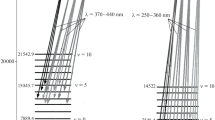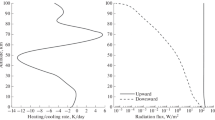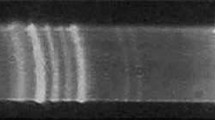Abstract
Processes of the excitation and quenching of electronically excited state \({{{\text{A}}}^{{\text{3}}}}\Sigma _{{\text{u}}}^{ + }\) of molecular oxygen in the Earth’s atmosphere at the altitudes of nightglow are considered. The calculated integrated intensities of Herzberg I bands are compared to experimental data obtained from space shuttle Discovery (STS-53). It is shown that the best agreement is observed upon adjusting quantum yields obtained earlier for the production of vibrational levels of the state \({{{\text{A}}}^{{\text{3}}}}\Sigma _{{\text{u}}}^{ + }\) in three-body collisions.



Similar content being viewed by others
REFERENCES
Shefov, N.N., Semenov, A.I., and Khomich, V.Yu., Izluchenie verkhnei atmosfery—indikator ee struktury i dinamiki (Radiation of the Upper Atmosphere—An Indicator of Its Structure and Dynamics), Moscow: GEOS, 2006.
Perminov, V.I., Semenov, A.I., and Shefov, N.N., Geomagn. Aeronom., 1998, vol. 38, no. 6, p. 642.
Semenov, A.I. and Shefov, N.N., Geomagn. Aeronom., 1999, vol. 39, no. 4, p. 87.
Kossyi, I.A., Kostinsky, A.Yu., Matveyev, A.A., and Silakov, V.P., Plasma Source Sci. Technol., 1992, vol. 1, no. 3, p. 207.
Gordillo-Vazquez, F.J., J. Phys. D: Appl. Phys., 2008, vol. 41, no. 23, 234016.
Broadfoot, A.L. and Kendall, K.R., J. Geophys. Res., 1968, vol. 73, no. 1, p. 426.
Bates, D.R., Planet. Space Sci., 1989, vol. 37, no. 7, p. 881.
Kirillov, A.S., Ann. Geophys., 2010, vol. 28, no. 1, p. 181.
Krasnopolsky, V.A., Planet. Space Sci., 2011, vol. 59, no. 8, p. 754.
Kirillov, A.S., Geomagn. Aeronom., 2012, vol. 52, no. 2, p. 258.
Broadfoot, A.L. and Bellaire, P.J., J. Geophys. Res., 1999, vol. 104, 17127.
Author information
Authors and Affiliations
Corresponding author
Additional information
Translated by L. Mukhortova
About this article
Cite this article
Antonenko, O.V., Kirillov, A.S. Modeling the Earth’s Nightglow Spectrum for Systems of Bands Emitted at Spontaneous Transitions between Different States of Electronically Excited Oxygen Molecules. Bull. Russ. Acad. Sci. Phys. 85, 219–223 (2021). https://doi.org/10.3103/S1062873821020040
Received:
Revised:
Accepted:
Published:
Issue Date:
DOI: https://doi.org/10.3103/S1062873821020040




